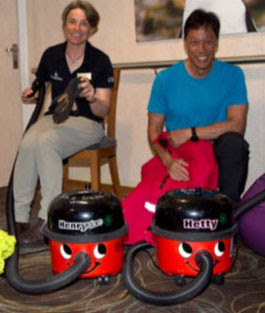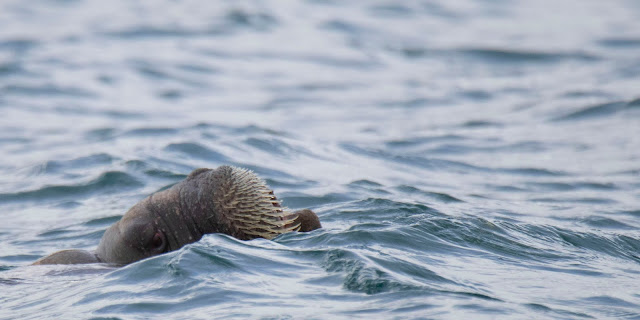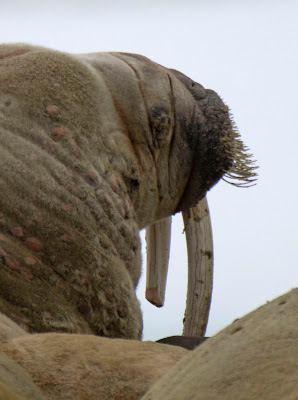 |
| A Zodiac heads to shore in Magdalenefjorden |
It looked cold and gray, although the temperature wasn’t actually that
low. And, with the low clouds, it was beautiful in a romantic, chilly, arctic
way.
 |
| Some sun peeked under the clouds |
 |
| Photo: Rosemarie Keough, G Adventures |
The first day was a much slower start than the rest of the trip because we had to be briefed on Zodiac and mudroom protocol, we had to be fitted for gumboots and we had to have our clothing and backpacks vacuumed for bio security. The arctic is a fragile environment; they don't want random seeds brought in on clothing. But, finally we were off to Magdalenefjorden (alternately spelled Magdalenafjorden), which, according to G Adventures, is one of the most beautiful and well-known fjords of Svalbard.
After a fairly uneventful (but gorgeous) Zodiac ride, we disembarked on a
very snowy, slushy and icy shore.
 |
| See how slushy the shore was? |
A Slushy, Slippy Walk
Uh oh! I envisioned our entire time slipping and sliding our way across the landscape.
Uh oh! I envisioned our entire time slipping and sliding our way across the landscape.
With big heavy cameras in a hand-held
waterproof bag, I was not ready for this. It was seriously treacherous. Fortunately, I did have my collapsible walking stick. I think the picture below adequately demonstrates why we wore knee-high gumboots and why waterproof pants are required.
 |
| That's me and my cameras in the middle; Photo: Rosemarie Keough, G Adventures photographer |
Almost every outing had two options – fast and slow. Fast was for people
who wanted a brisk hike for exercise. Slow was for people like me who need to
take a million gazillion photos. Every time, I picked slow. This time I, along
with many others, didn’t even go the full distance for slow. I sure didn’t want
to fall and injure myself on day one.
 |
| Photo: Rosemarie Keough, G Adventures photographer |
The good news was that we never again encountered snow and ice where we
had to walk (bogs, yes, but that’s another story for another post). And, Scott
bought me a waterproof backpack that evening, so I was able to carry cameras hands-free.
 |
| Map: G Adventures |
Magdalenefjorden
Magdalenefjorden is fairly far north; I was surprised at how much progress the ship had made during the night while we were sleeping. And, that was the normal way we progressed. We stopped and did activities during the day and the ship relocated during the night, which, of course, was just as bright as the day.
Magdalenefjorden is fairly far north; I was surprised at how much progress the ship had made during the night while we were sleeping. And, that was the normal way we progressed. We stopped and did activities during the day and the ship relocated during the night, which, of course, was just as bright as the day.
So, we arrived on the northwest edge of Svalbard to explore Magdalenefjorden.
Magdalenefjorden cuts six miles straight into the coast and averages about one
to two miles wide. Even though it was the snowiest place we visited, the fjord
itself seldom freezes because of the influence of the West-Spitsbergen current
(AKA Gulfstream).
On the south shore of the fjord is the bay Gullybukta. The fjord is feed by several glaciers, including Waggonwaybreen.
On the south shore of the fjord is the bay Gullybukta. The fjord is feed by several glaciers, including Waggonwaybreen.
William Barentsz explored Magdalenefjorden in 1596 and named the area Tusk
Bay because he had found some Walrus tusks there. English explorer and whaler
Robert Fotherby entered the fjord in 1614 and claimed it for King James I of
England. He named the fjord Maudlen Sound and the small, sheltered bay on its
southern shore Trinity Harbor. The English subsequently established a whaling
station in Trinity Harbor, on what is now called Gravneset. It was later taken
over by the Dutch.
The remains of four blubber ovens or furnaces have been found on Gravneset, as well as a graveyard containing about 130 graves dating from the 17th to the late 18th century. The fast walkers may have gone there. We walked up to a little hut built by Norwegian trappers in the early 20th century. I read that the barriers on shore protect some of the historically significant areas. Barriers are somewhat unusual in Svalbard, which counts on tourists and tour companies to behave.
Magdalenefjorden has Alpine scenery with jagged mountain peaks, to which
the island of Spitsbergen (“pointed mountains”) owes its name. The highest
mountain of the Magdalenefjorden area is 3,600-foot high Hornemanntoppen.
The remains of four blubber ovens or furnaces have been found on Gravneset, as well as a graveyard containing about 130 graves dating from the 17th to the late 18th century. The fast walkers may have gone there. We walked up to a little hut built by Norwegian trappers in the early 20th century. I read that the barriers on shore protect some of the historically significant areas. Barriers are somewhat unusual in Svalbard, which counts on tourists and tour companies to behave.
 |
| Magdalenefjorden can accommodate bigger ships than other places |
 |
| Jagged mountains rise above the sea |
Because Magdalenefjorden is steep and rocky, it has very little
vegetation. While on shore, we saw no wildlife, except some very perky Snow Buntings.
 |
| Snow Bunting |
They looked so pretty against the black granite and white snow. It was a treat
to see them in their truly natural habitat.
 |
| Snow Bunting |
Apparently, sometimes Svalbard
Reindeer are seen there, as are Polar Bears. In 1977, an Austrian mountaineer
was killed by a Polar Bear in a camp on the north side of the fjord.
 |
| One of our bear guards; the barrier behind him protects historically significant land |
After we looked around a bit, our guides asked us if we wanted to go see
some Walruses hauled out on a spit nearby. Did we? Duh, yeah!
Now it was getting interesting.
Walruses
We shuffled back to the Zodiacs, loaded up and took off toward the haul-out. The ride we quite pretty and included some very good views of the Waggonwaybreen glacier.
We shuffled back to the Zodiacs, loaded up and took off toward the haul-out. The ride we quite pretty and included some very good views of the Waggonwaybreen glacier.
 |
| Left, Scott scouting the glacier; right, one of the other Zodiacs |
The Walruses sure know how to pick a nice neighborhood.
 |
| A very nice place to nap |
 |
| Haul-out |
After we had been there awhile, a few dragged themselves into the water
and swam near the Zodiacs.
 |
| Swimming Walrus |
This was the first of three really good Walrus sightings on our trip and
it was our first new animal sighting.
 |
| The Zodiac affords a good view |
I will give a bit of information on walruses here and then add a bit more
when I talk about our other sightings.
The Walrus is a large
flippered pinniped marine mammal that lives in the Arctic Ocean and subarctic
seas of the Northern Hemisphere. They do not inhabit Antarctica.
The word Walrus may derive from the Dutch walvis, which means “whale” or it may be old Norse from the word hrossvalr, that means “horse-whale.” An alternative theory is that it comes from the Dutch words wal (“shore”) and reus (“giant”). They certainly are giant.
 |
| All those marks are scars |
 |
| They are known for tusks and whiskers |
The Walrus has played a prominent role in the cultures of many indigenous Arctic peoples, who have hunted them for centuries for meat, fat, skin, tusks and bone.
However, during the 19th century and the early 20th century their "market" was expanded and they were widely hunted and killed for their blubber, ivory and meat, resulting in dramatic drops in populations.
They have rebounded somewhat since then but are now threatened by shrinking sea ice.
Walruses are
thought to have evolved from a tropical or subtropical ancestor that became
isolated in the Atlantic Ocean and gradually adapted to colder conditions in
the Arctic. From there, some presumably recolonized the North Pacific Ocean
during high glaciation periods about 500,000 to 785,000 years ago.
The only living
species in its family, the Walrus has three subspecies: the Atlantic Walrus,
the Pacific Walrus and the Laptev Walrus. Obviously, we saw the Atlantic
subspecies.
 |
| Such a treat to see actual wild Walruses! |
 |
| This is a pretty one! |
 |
| Lumbering into the surf |
 |
| That's one way to get into the water |
They frequently stop to
rest in the middle of a move. They are much more agile in the water.
 |
| Walruses in the water |
Walruses, which look very much like the actor Wilford Brimley, have bulbous eyes that they can protrude to see both forward and sideways, although their vision is
rather short-range. The eyes often look bloodshot, giving them a look of extreme world-weariness.
 |
| Their eyes protrude and they have no external ears |
 |
| Often the tusks get broken |
The Walrus’
most prominent feature is its long tusks.
Both males and females have these elongated canines, but the adult males' are much longer and thicker.
Tusks can be longer than three feet and can weigh up to 12 lbs. each.
Males use tusks for fighting, dominance and display; the strongest males with the largest tusks typically dominate social groups.
Tusks are also used to form and maintain holes in the ice and aid the Walrus in climbing out of water onto ice. Walruses generally have relatively few teeth other than their tusks.
Both males and females have these elongated canines, but the adult males' are much longer and thicker.
Tusks can be longer than three feet and can weigh up to 12 lbs. each.
Males use tusks for fighting, dominance and display; the strongest males with the largest tusks typically dominate social groups.
Tusks are also used to form and maintain holes in the ice and aid the Walrus in climbing out of water onto ice. Walruses generally have relatively few teeth other than their tusks.
 |
| Tusks are used for dominance and locomotion |
As I said, these
were not the first Walruses we saw. I’ll share more information about them
later.
 |
| Scott and Hella in the Zodiac |
As we were floating near the Walruses, we had a little drama when our Zodiac stalled and the engine would not start.
It turns out this happened as few times throughout the next week.
Zodiac engines are finicky.
When Hella, our Zodiac driver that day, got the engine started, she needed to get back to the ship as quickly as she could, so we didn't get to spend much time with the swimming Walruses.
A bit disappointing at the time, but we ended up with plenty of Walrus time, so it's all good!
At least, I think Scott was happy!
Polar Plunge
They gave us an option that day to do a Polar Plunge. No thanks! I grew up in Florida and I do not like cold water. Plus, getting in and out of gear on shore would be a pain. But, a surprisingly large number of out fellow passengers did it.
 |
| Scott loving the Walruses |
They gave us an option that day to do a Polar Plunge. No thanks! I grew up in Florida and I do not like cold water. Plus, getting in and out of gear on shore would be a pain. But, a surprisingly large number of out fellow passengers did it.
 |
| These people are crazy! Photo: Rosemarie Keough |
Trip date: June 15-July 4, 2019

No comments:
Post a Comment